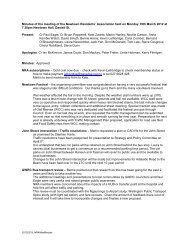Draft Town Belt Management Plan - Wellington City Council
Draft Town Belt Management Plan - Wellington City Council
Draft Town Belt Management Plan - Wellington City Council
Create successful ePaper yourself
Turn your PDF publications into a flip-book with our unique Google optimized e-Paper software.
Regeneration of native vegetation after pine removal<br />
and ongoing weed control, Te Ahumairangi Hill.<br />
Top: In 2005 Bottom: In 2011<br />
can be seen in the<br />
photographs on the left that<br />
show a part of the hill<br />
following tree removal and<br />
then six years later.<br />
Pest animals are also a<br />
problem, particularly<br />
possums, rats and<br />
mustelids (stoats, ferrets<br />
and weasels). Possums are<br />
controlled in the <strong>Town</strong> <strong>Belt</strong><br />
as part of <strong>Wellington</strong> <strong>City</strong><br />
<strong>Council</strong> and Greater<br />
<strong>Wellington</strong> Regional<br />
<strong>Council</strong>’s shared possumcontrol<br />
programme. This<br />
programme is thought to be<br />
contributing to increased<br />
numbers of native birds and<br />
improved forest<br />
regeneration and health.<br />
Mustelids are a particular<br />
threat to native birds<br />
(including eating eggs),<br />
lizards and insects (eg<br />
weta). Mustelid control<br />
requires intensive trap<br />
checking and is most<br />
successful where<br />
community groups are able<br />
to help. Feral and domestic<br />
cats are also a significant<br />
threat to native wildlife,<br />
particularly lizards and<br />
birds.<br />
<strong>Wellington</strong> <strong>City</strong> <strong>Council</strong>’s<br />
Pest <strong>Management</strong> <strong>Plan</strong><br />
(2004) identifies three<br />
kinds of pest control:<br />
species-led, site-led and<br />
amenity.<br />
Species-led programmes are particularly relevant in managing weeds and pest animals in the early<br />
stages of establishment when numbers are low and distribution is limited.<br />
Site-led programmes focus on areas of high biodiversity value and prioritise the control and<br />
management of pests that pose the greatest threats to these values. The Pest <strong>Management</strong><br />
Implementation <strong>Plan</strong> prioritises sites for weed control and pest animal control on a citywide basis.<br />
Priorities for pest control should also recognise specific opportunities for the <strong>Town</strong> <strong>Belt</strong> as<br />
resources allow. Key opportunities are to manage pests in parts of the <strong>Town</strong> <strong>Belt</strong> that are<br />
representative examples of the biodiversity of the central city area, to prioritise areas important for<br />
ecological connectivity, and to carry out amenity weed control where weeds are impacting on the<br />
<strong>Draft</strong> <strong>Town</strong> <strong>Belt</strong> <strong>Management</strong> <strong>Plan</strong> October 2012 37





